 Climate Change Research Letters 气候变化研究快报, 2013, 2, 159-164 http://dx.doi.org/10.12677/ccrl.2013.24027 Published Online October 2013 (http://www.hanspub.org/journal/ccrl.html) A Study of Particulate Organic Carbon Export in the Yellow Sea in Summer Based on 234Th:238U Disequilibrium Daochen Zhao College of the Environment and Ecology, Xiamen University, Xiamen Email: zdc@stu.xmu.edu.cn Received: Jul. 29th, 2013; revised: Aug. 25th, 2013; accepted: Sep. 2nd, 2013 Copyright © 2013 Daochen Zhao. This is an open access article distributed under the Creative Commons Attribution License, which permits unre- stricted use, distribution, and reproduction in any medium, provided the original work is properly cited. Abstract: 234Th was utilized as a tracer of particulate organic carbon (POC) fluxes from the euphotic zone to study bio- logical pump process in the Yellow Sea in the summer of 2009. 234Th in the upper water column was determined by using a modified small-volume MnO2 co-precipitation technique, and its deficit with respect to 238U was found to be evident throughout the upper water column. The 234Th :238U disequilibrium in the upper waters and one-dimensional irreversible steady state model were used to calculate the POC export fluxes from the bottom of euphotic layer. The POC export flux varied from 12.7 ± 1.7 mmol C m−2·d−1 to 92.0 ± 21.0 mmol C m−2·d−1, with an average of 45.3 ± 41.5 mmol C m−2·d−1 (n = 3, ±1SD). The results will provide a better understanding of the role that the Yellow Sea plays in the global carbon cycle. Keywords: Yellow Sea; POC Export Fluxes; 234Th; Euphotic Zone 夏季黄海颗粒有机碳的输出通量——基于 234Th:238U 不平衡方法的研究 赵道辰 厦门大学环境与生态学院,厦门 Email: zdc@stu.xmu.edu.cn 收稿日期:2013 年7月29 日;修回日期:2013年8月25 日;录用日期:2013年9月2日 摘 要:为了研究黄海生物泵过程,2009年夏季利用 234Th 示踪法对黄海进行了颗粒有机碳输出通量的研究。 以小体积海水MnO2共沉淀-β计数法测定海水中总态及颗粒态234Th的活度,在上层水柱中颗粒态及总态 234Th 活度显著低于母体238U的活度。基于上层水体中234Th:238U的不平衡并结合一维稳态不可逆清除模型,估算出 从真光层底部输出的 POC 通量。夏季黄海颗粒有机碳的输出通量变化范围为 12.7 ± 1.7~92.0 ± 21.0 mmol C m−2·d−1,平均值为 45.3 ± 41.5 mmol C m−2·d−1 (n = 3, ±1SD)。本研究结果为进一步厘清黄海在全球碳循环的作用提 供了参考。 关键词:黄海;颗粒有机碳输出通量;234Th;真光层 1. 引言 在稳态条件下,新生产力等于真光层中有机物的 输出[1](即输出生产力),因此真光层的输出生产力反映 浮游植物固定的CO2进入深海的量,它包括颗粒有机 碳(Paticulate Organic Carbon, POC)的沉降输出和溶解 有机碳(Dissolved Organic Carbon, DOC)的扩散/对流 输出。利用物理混合和浓度梯度计算发现全球海洋溶 解有机碳的向下输出通量为0.1~0.3 × 109 tons C·yr−1, Copyright © 2013 Hanspub 159 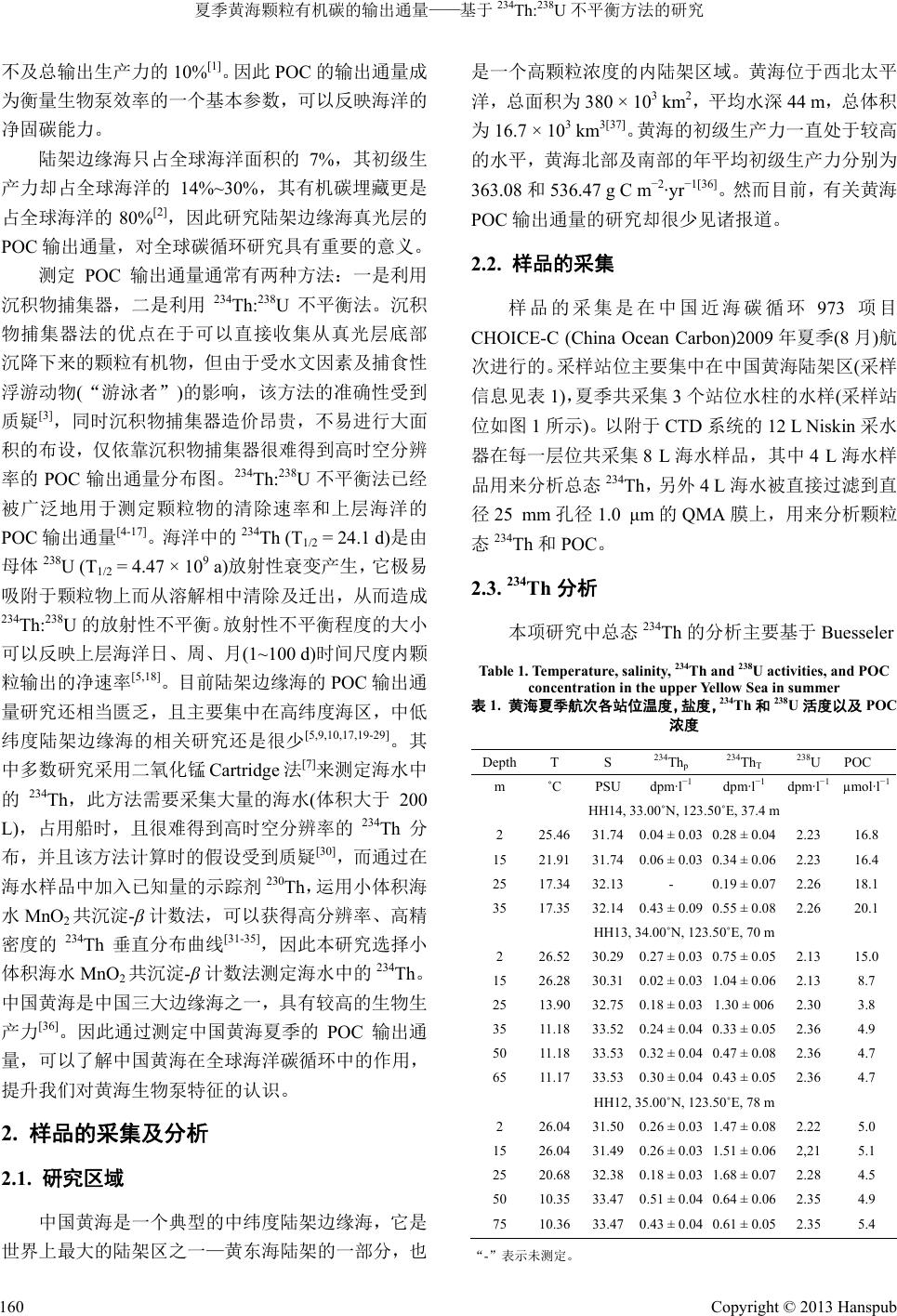 夏季黄海颗粒有机碳的输出通量——基于 234Th:238U不平衡方法的研究 不及总输出生产力的 10%[1]。因此 POC 的输出通量成 为衡量生物泵效率的一个基本参数,可以反映海洋的 净固碳能力。 陆架边缘海只占全球海洋面积的 7%,其初级生 产力却占全球海洋的 14%~30%,其有机碳埋藏更是 占全球海洋的 80%[2],因此研究陆架边缘海真光层的 POC 输出通量,对全球碳循环研究具有重要的意义。 测定 POC 输出通量通常有两种方法:一是利用 沉积物捕集器,二是利用 234Th:238U不平衡法。沉积 物捕集器法的优点在于可以直接收集从真光层底部 沉降下来的颗粒有机物,但由于受水文因素及捕食性 浮游动物(“游泳者”)的影响,该方法的准确性受到 质疑[3],同时沉积物捕集器造价昂贵,不易进行大面 积的布设,仅依靠沉积物捕集器很难得到高时空分辨 率的 POC 输出通量分布图。234Th:238U不平衡法已经 被广泛地用于测定颗粒物的清除速率和上层海洋的 POC 输出通量[4-17]。海 洋 中 的234Th (T1/2 = 24.1 d)是由 母体 238U (T1/2 = 4.47 × 109 a)放射性衰变产生,它极易 吸附于颗粒物上而从溶解相中清除及迁出,从而造成 234Th:238U的放射性不平衡。放射性不平衡程度的大小 可以反映上层海洋日、周、月(1~100 d)时间尺度内颗 粒输出的净速率[5,18]。目前陆架边缘海的 POC 输出通 量研究还相当匮乏,且主要集中在高纬度海区,中低 纬度陆架边缘海的相关研究还是很少[5,9,10,17,19-29]。其 中多数研究采用二氧化锰 Cartridge 法[7]来测定海水中 的234Th,此方法需要采集大量的海水(体积大于200 L),占用船时,且很难得到高时空分辨率的234Th 分 布,并且该方法计算时的假设受到质疑[30],而通过在 海水样品中加入已知量的示踪剂230Th,运用小体积海 水MnO2共沉淀-β计数法,可以获得高分辨率、高精 密度的 234Th 垂直分布曲线[31-35],因此本研究选择小 体积海水MnO2共沉淀-β计数法测定海水中的234Th。 中国黄海是中国三大边缘海之一,具有较高的生物生 产力[36]。因此通过测定中国黄海夏季的POC 输出通 量,可以了解中国黄海在全球海洋碳循环中的作用, 提升我们对黄海生物泵特征的认识。 2. 样品的采集及分析 2.1. 研究区域 中国黄海是一个典型的中纬度陆架边缘海,它是 世界上最大的陆架区之一—黄东海陆架的一部分,也 是一个高颗粒浓度的内陆架区域。黄海位于西北太平 洋,总面积为 380 × 103 km2,平均水深 44 m,总体积 为16.7 × 103 km3[37]。黄海的初级生产力一直处于较高 的水平,黄海北部及南部的年平均初级生产力分别为 363.08和536.47 g C m−2·yr−1[36]。然而目前,有关黄海 POC 输出通量的研究却很少见诸报道。 2.2. 样品的采集 样品的采集是在中国近海碳循环973 项目 CHOICE-C (China Ocean Carbon)2009年夏季(8 月)航 次进行的。采样站位主要集中在中国黄海陆架区(采样 信息见表1),夏季共采集 3个站位水柱的水样(采样站 位如图 1所示)。以 附于CTD 系统的 12 L Niskin 采水 器在每一层位共采集 8 L海水样品,其中 4 L海水样 品用来分析总态234Th,另外 4 L 海水被直接过滤到直 径25 mm孔径 1.0 μm的QMA 膜上,用来分析颗粒 态234Th 和POC。 2.3. 234Th 分析 本项研究中总态234Th 的分析主要基于Buesseler Table 1. Temperature, salinity, 234Th and 238U activities, and POC concentration in the upper Yellow Sea in summer 表1. 黄海夏季航次各站位温度,盐度, 234Th 和238U活度以及 POC 浓度 DepthT S 234Thp 234ThT 238U POC m ˚C PSU dpm·l−1 dpm·l−1 dpm·l−1µmol·l−1 HH14, 33.00˚N, 123.50˚E, 37.4 m 2 25.4631.740.04 ± 0.03 0.28 ± 0.04 2.23 16.8 15 21.9131.740.06 ± 0.03 0.34 ± 0.06 2.23 16.4 25 17.3432.13- 0.19 ± 0.07 2.26 18.1 35 17.3532.140.43 ± 0.09 0.55 ± 0.08 2.26 20.1 HH13, 34.00˚N, 123.50˚E, 70 m 2 26.5230.290.27 ± 0.03 0.75 ± 0.05 2.13 15.0 15 26.2830.310.02 ± 0.03 1.04 ± 0.06 2.13 8.7 25 13.9032.750.18 ± 0.03 1.30 ± 006 2.30 3.8 35 11.1833.520.24 ± 0.04 0.33 ± 0.05 2.36 4.9 50 11.1833.530.32 ± 0.04 0.47 ± 0.08 2.36 4.7 65 11.1733.530.30 ± 0.04 0.43 ± 0.05 2.36 4.7 HH12, 35.00˚N, 123.50˚E, 78 m 2 26.0431.500.26 ± 0.03 1.47 ± 0.08 2.22 5.0 15 26.0431.490.26 ± 0.03 1.51 ± 0.06 2,21 5.1 25 20.6832.380.18 ± 0.03 1.68 ± 0.07 2.28 4.5 50 10.3533.470.51 ± 0.04 0.64 ± 0.06 2.35 4.9 75 10.3633.470.43 ± 0.04 0.61 ± 0.05 2.35 5.4 “-”表示未测定。 Copyright © 2013 Hanspub 160 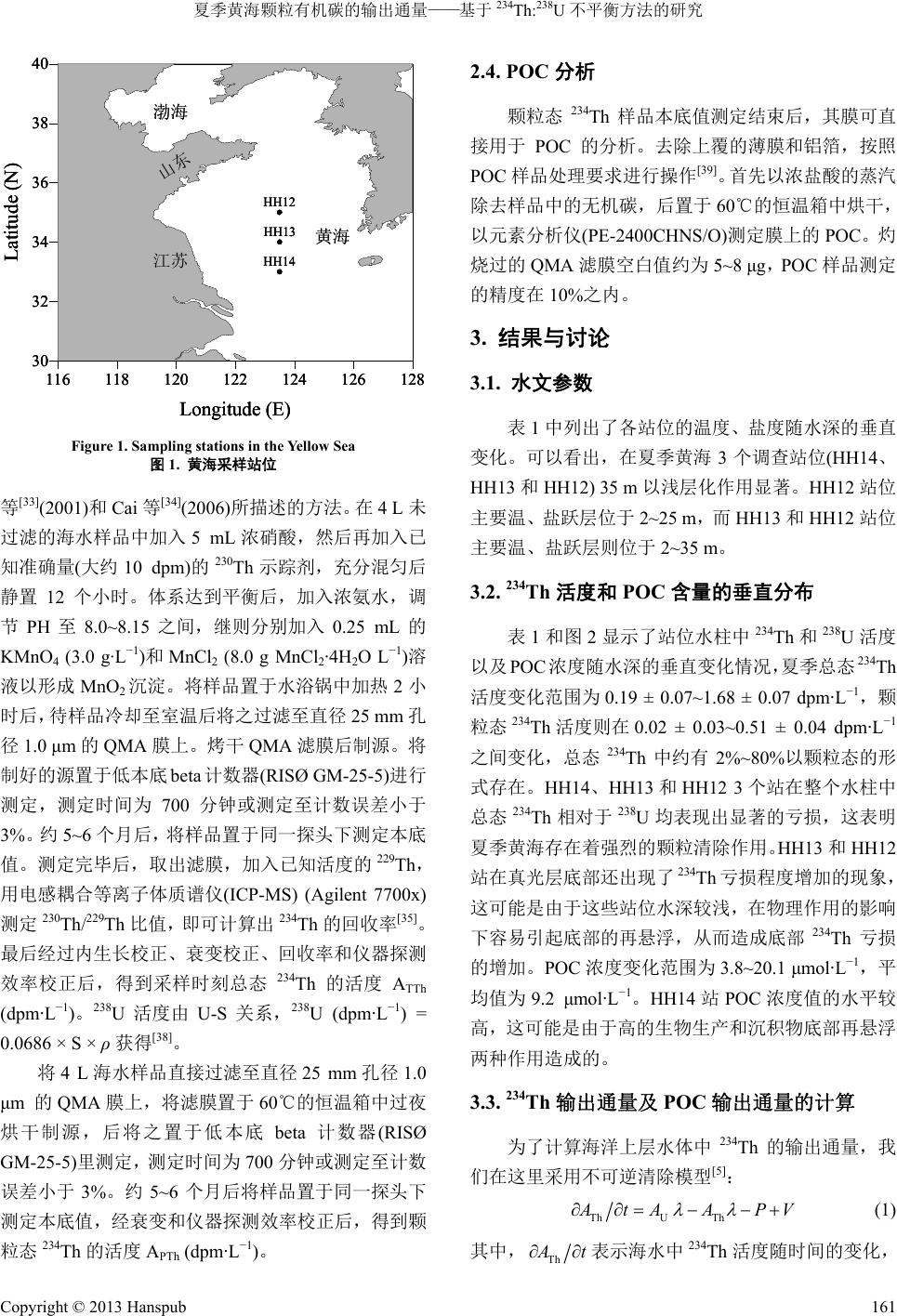 夏季黄海颗粒有机碳的输出通量——基于 234Th:238U不平衡方法的研究 HH14 HH13 HH12 116 118 120 122 124 126 128 Longitude (E) 30 32 34 36 38 40 L a t i t ude (N) 山东 江苏 渤海 黄海 HH14 HH13 HH12 116 118 120 122 124 126 128 Longitude (E) 30 32 34 36 38 40 L a t i t ude (N) 山东 江苏 HH14 HH13 HH12 116 118 120 122 124 126 128 Longitude (E) 30 32 34 36 38 40 L a t i t ude (N) 山东 江苏 渤海 黄海 Figure 1. Sampling stations in the Yellow Sea 图1. 黄海采样站位 等[33](2001)和Cai 等[34](2006) 所描述的方法。在4 L 未 过滤的海水样品中加入 5 mL浓硝酸,然后再加入已 知准确量(大约 10 dpm)的230Th 示踪剂,充分混匀后 静置 12 个小时。体系达到平衡后,加入浓氨水,调 节PH 至8.0~8.15 之间,继则分别加入 0.25 mL的 KMnO4 (3.0 g·L−1)和MnCl2 (8.0 g MnCl2·4H2O L−1)溶 液以形成 MnO2沉淀。将样品置于水浴锅中加热 2小 时后,待样品冷却至室温后将之过滤至直径25 mm 孔 径1.0 μm的QMA 膜上。烤干 QMA滤膜后制源。将 制好的源置于低本底 beta 计数器(RISØ GM-25-5)进行 测定,测定时间为 700 分钟或测定至计数误差小于 3%。约 5~6个月后,将样品置于同一探头下测定本底 值。测定完毕后,取出滤膜,加入已知活度的229Th, 用电感耦合等离子体质谱仪(ICP-MS) (Agilent 7700x) 测定 230Th/229Th 比值,即可计算出234Th 的回收率[35]。 最后经过内生长校正、衰变校正、回收率和仪器探测 效率校正后,得到采样时刻总态 234Th 的活度 ATTh (dpm·L−1)。238U活度由 U-S关系,238U (dpm·L−1) = 0.0686 × S × ρ获得[38]。 将4 L海水样品直接过滤至直径 25 mm孔径 1.0 μm 的QMA 膜上,将滤膜置于 60℃的恒温箱中过夜 烘干制源,后将之置于低本底 beta 计数器(RISØ GM-25-5)里测定,测定时间为 700 分钟或测定至计数 误差小于 3%。约 5~6 个月后将样品置于同一探头下 测定本底值,经衰变和仪器探测效率校正后,得到颗 2.4. POC分析 粒态 234Th的活度 APTh (dpm·L−1)。 Th 样品本底值测定结束后,其膜可直 接用 表1中列出了各站位的温度、盐度随水深的垂直 变化。可 3.2. Th活度和 POC 表2显水柱中 Th 和238U活度 以及 POC 输出通量的计算 为了计算海洋上层水体 Th的输出通量,我 们在 颗粒态 234 于POC的分析。去除上覆的薄膜和铝箔,按照 POC 样品处理要求进行操作[39]。首先以浓盐酸的蒸汽 除去样品中的无机碳,后置于60℃的恒温箱中烘干, 以元素分析仪(PE-2400CHNS/O)测定膜上的 POC。灼 烧过的 QMA 滤膜空白值约为5~8 μg,POC 样品测定 的精度在10%之内。 3. 结果与讨论 3.1. 水文参数 以看出,在夏季黄海3个调查站位(H H14、 HH13 和HH12) 35 m 以浅层化作用显著。HH12 站位 主要温、盐跃层位于 2~25 m,而HH13 和HH12 站位 主要温、盐跃层则位于2~35 m。 234 含量的垂直分布 1和图 示了站位 234 POC浓度随水深的垂直变化情况,夏季总态234Th 活度变化范围为0.19 ± 0.07~1.68 ± 0.07 dpm·L−1,颗 粒态 234Th活度则在 0.02 ± 0.03~0.51 ± 0.04 dpm·L−1 之间变化,总态 234Th 中约有2%~80%以颗粒态的形 式存在。HH14、HH13 和HH12 3个站在整个水柱中 总态 234Th 相对于 238U均表现出显著的亏损,这表明 夏季黄海存在着强烈的颗粒清除作用。HH13 和HH12 站在真光层底部还出现了 234Th亏损程度增加的现象, 这可能是由于这些站位水深较浅,在物理作用的影响 下容易引起底部的再悬浮,从而造成底部 234Th亏损 的增加。POC 浓度变化范围为 3.8~20.1 μmo l ·L−1,平 均值为 9.2 μmol·L−1。HH14 站POC 浓度值的水平较 高,这可能是由于高的生物生产和沉积物底部再悬浮 两种作用造成的。 3.3. 234Th 输出通量及 中234 这里采用不可逆清除模型[5]: ThU Th A tA A PV (1) 其中,表示海水中234Th 活度随时 Th A t 间的变化, Copyright © 2013 Hanspub 161 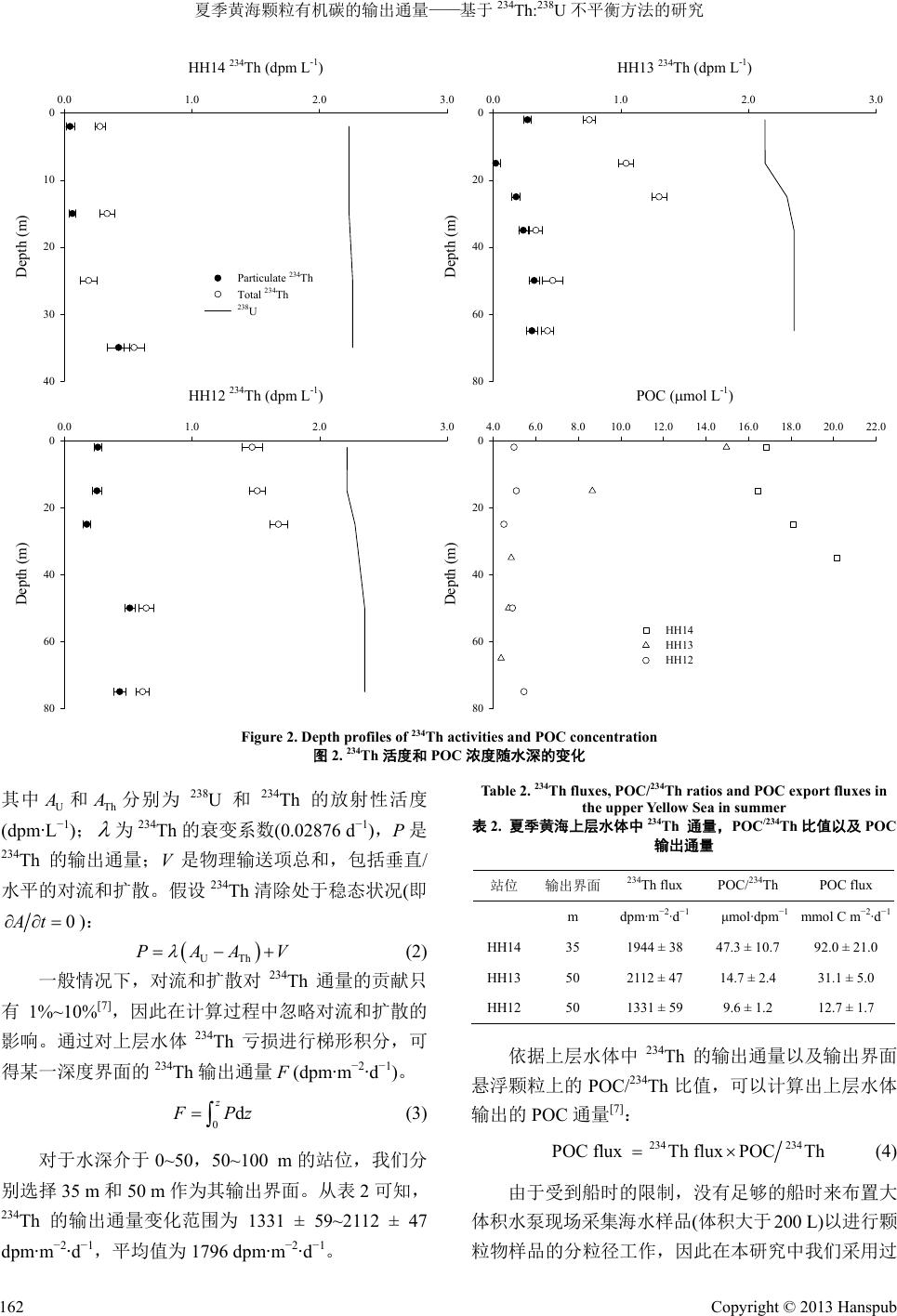 夏季黄海颗粒有机碳的输出通量——基于 234Th:238U不平衡方法的研究 Copyright © 2013 Hanspub 162 HH14 234Th (dpm L-1)HH13 234Th (dpm L-1) 0.0 1.0 2.0 3.0 Depth (m) 0 10 20 30 40 Particulate 234Th Total 234Th 238U 0.0 1.0 2.0 3.0 Depth (m) 0 20 40 60 80 HH12 234Th (dpm L-1)POC (mol L-1) 0.0 1.0 2.0 3.0 Depth (m) 0 20 40 60 80 4.06.08.010.0 12.014.0 16.018.0 20.0 22.0 Depth (m) 0 20 40 60 80 HH14 HH13 HH12 Figure 2. Depth profiles of 234Th activities and POC concentration 234 中 图2. Th 活度和 POC浓度随水深的变化 其U A 和Th A 分别为 238U和234Th 的放射性活度 (dpm·);L−1 为 通 234Th 的衰变系数(0.02876 d−1),P是 234Th 的输出 量;V是物理输送项总和,包括垂直/ 水平的对流和扩散。假设234Th 清除处于稳态状况(即 0At): UTh PAA V (2) 一般情况下,对流和扩散对 234T 有1 h通量的贡献只 %~10%[7],因此在计算过程中忽略对流和扩散的 影响。通过对上层水体 234Th亏损进行梯形积分,可 得某一深度界面的234Th 输出通量 F (dpm·m−2·d−1)。 z 0d F Pz (3) 对于水深介于0~50,50~100 m的站位,我们分 别选 es, POC/234Th ratios and POC export fluxes in the upper Yellow Sea in summer 以及 POC Table 2. 234Th flux 择35 m 和50 m 作为其输出界面。从表 2可知, 234Th 的输出通量变化范围为 1331 ± 59~2112 ± 47 dpm·m−2·d−1,平均值为1796 dpm·m−2·d−1。 表2. 夏季黄海上层水体中 234Th 通量,POC/234Th 比值 输出通量 站位 输出界面 234Th flux POC/234Th POC flux m dpm·mμmol·dpm−1 mmol C m−2·d−1−2·d−1 HH14 35 1944 ± 38 47.3 ± 10.7 92.0 ± 21.0 HH13 50 2112 ± 47 14.7 ± 2.4 31.1 ± 5.0 HH12 50 1331 ± 59 9.6 ± 1.2 12.7 ± 1.7 上中 234 的输 以及 浮颗粒上的 POC/Th比值,可以计算出上层水体 输出 依据 层水体Th 234 出通量 输出界面 悬 的POC通量[7]: 234 234 POC flux Th fluxPOCTh (4) 由于受到船时的限制,没有足够的船时来布置大 体积水泵现场采集海水样品(体积大于 200 L) 粒物 以进行颗 样品的分粒径工作,因此在本研究中我们采用过 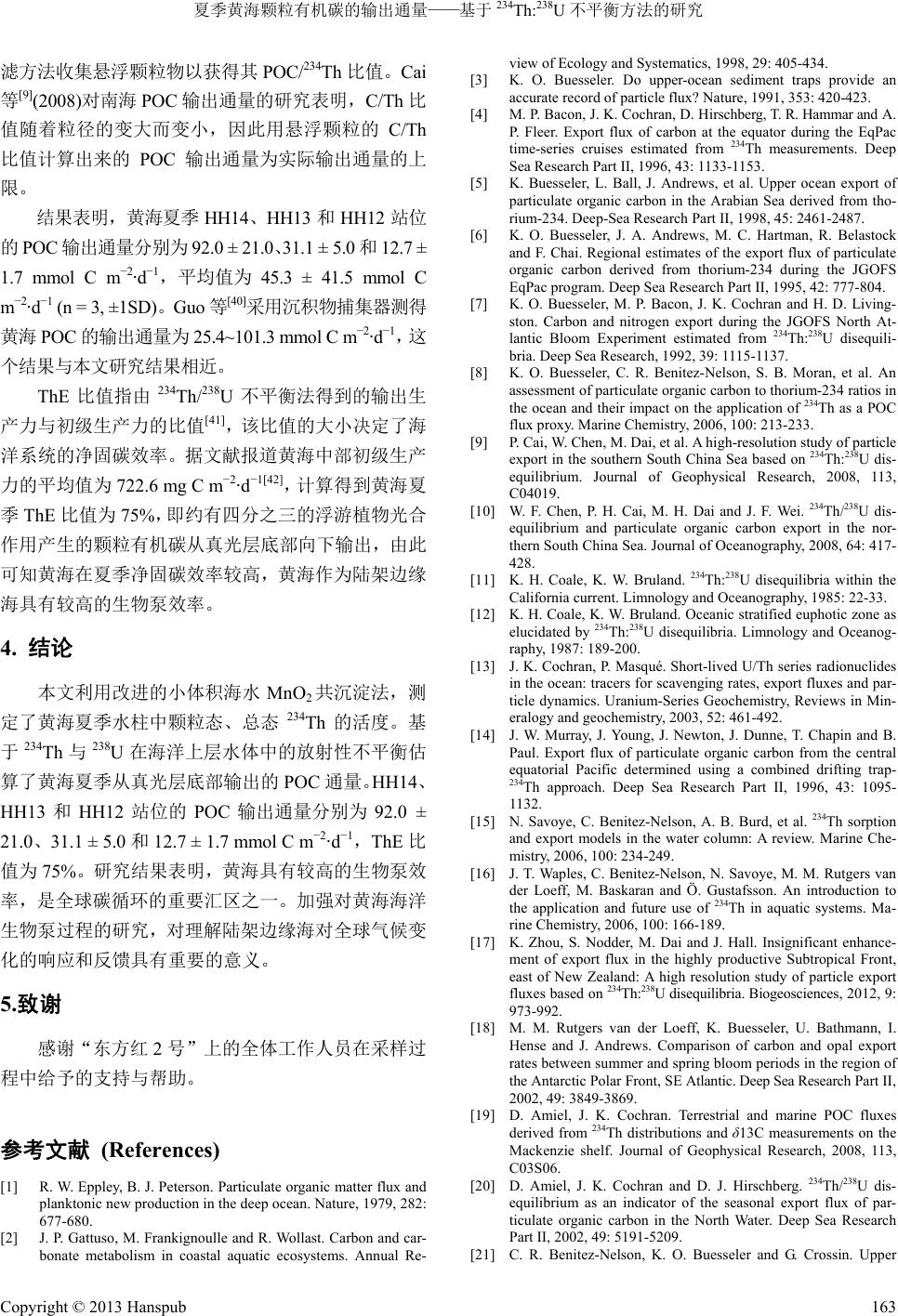 夏季黄海颗粒有机碳的输出通量——基于 234Th:238U不平衡方法的研究 滤方法收集悬浮颗粒物以获得其 POC/234Th比值。Cai 等[9](2008)对南海 POC 输出通量的研究表明,C/Th比 值随着粒径的变大而变小,因此用悬浮颗粒的 C/Th 比值计算出来的 POC输出通量为实际输出通量的上 限。 结果表明,黄海夏季HH14、HH13和HH12站位 的POC输出通量分别为92.0 ± 21.0、31.1 ± 5.0和12.7 ± 1.7 比值的大小决定了海 洋系统的 4. 结论 改进的小体积海水MnO2共沉淀法,测 水柱中颗粒态、总态 234Th的活度。 于23 “东方红 2号”上的全体工作人员在采样过 的支持与帮助。 [1] R. W. Eppley, B. J. Peterson. Particulate organic matter flux deep ocean. Nature, 1979, 282: esseler. Do upper-ocean sediment traps provide an he EqPac rtman, R. Belastock 4. 33. ated by Th: U disequilibria. Limnology and Oceanog- ry, 2003, 52: 461-492. 43: 1095- aples, C. Benitez-Nelson, N. Savoye, M. M. Rutgers van 6-189. a. Biogeosciences, 2012, 9: tic Polar Front, SE Atlantic. Deep Sea Research Part II, 02, 49: 5191-5209. and mmol C m−2·d−1,平均值为 45.3 ± 41.5 mmol C m−2·d−1 (n = 3, ±1SD)。Guo等[40]采用沉积物捕集器测得 黄海 POC 的输出通量为25.4~101.3 mmol C m−2·d−1,这 个结果与本文研究结果相近。 ThE 比值指由 234Th/238U不平衡法得到的输出生 产力与初级生产力的比值[41],该 净固碳效率。据文献报道黄海中部初级生产 力的平均值为722.6 mg C m−2·d−1[42],计算得到黄海夏 季ThE 比值为 75%,即约有四分之三的浮游植物光合 作用产生的颗粒有机碳从真光层底部向下输出,由此 可知黄海在夏季净固碳效率较高,黄海作为陆架边缘 海具有较高的生物泵效率。 本文利用 定了黄海夏季 基[1 4Th 与238U在海洋上层水体中的放射性不平衡估 算了黄海夏季从真光层底部输出的POC 通量。HH14、 HH13和HH12 站位的 POC 输出通量分别为 92.0 ± 21.0、31.1 ± 5.0 和12.7 ± 1.7 mmol C m−2·d−1,ThE比 值为 75%。研究结果表明,黄海具有较高的生物泵效 率,是全球碳循环的重要汇区之一。加强对黄海海洋 生物泵过程的研究,对理解陆架边缘海对全球气候变 化的响应和反馈具有重要的意义。 5.致谢 感谢 程中给予 参考文献 (References) and planktonic new production in the 677-680. [2] J. P. Gattuso, M. Frankignoulle and R. Wollast. Carbon and car- bonate metabolism in coastal aquatic ecosystems. Annual Re- view of Ecology and Systematics, 1998, 29: 405-434. [3] K. O. Bu accurate record of particle flux? Nature, 1991, 353: 420-423. [4] M. P. Bacon, J. K. Cochran, D. Hirschberg, T. R. Hammar and A. P. Fleer. Export flux of carbon at the equator during t time-series cruises estimated from 234Th measurements. Deep Sea Research Part II, 1996, 43: 1133-1153. [5] K. Buesseler, L. Ball, J. Andrews, et al. Upper ocean export of particulate organic carbon in the Arabian Sea derived from tho- rium-234. Deep-Sea Research Part II, 1998, 45: 2461-2487. [6] K. O. Buesseler, J. A. Andrews, M. C. Ha F. Chai. Regional estimates of the export flux of particulate organic carbon derived from thorium-234 during the JGOFS EqPac program. Deep Sea Research Part II, 1995, 42: 777-80 [7] K. O. Buesseler, M. P. Bacon, J. K. Cochran and H. D. Living- ston. Carbon and nitrogen export during the JGOFS North At- lantic Bloom Experiment estimated from 234Th:238U disequili- bria. Deep Sea Research, 1992, 39: 1115-1137. [8] K. O. Buesseler, C. R. Benitez-Nelson, S. B. Moran, et al. An assessment of particulate organic carbon to thorium-234 ratios in the ocean and their impact on the application of 234Th as a POC flux proxy. Marine Chemistry, 2006, 100: 213-2 [9] P. Cai, W. Chen, M. Dai, et al. A high-resolution study of particle export in the southern South China Sea based on 234Th:238U dis- equilibrium. Journal of Geophysical Research, 2008, 113, C04019. [10] W. F. Chen, P. H. Cai, M. H. Dai and J. F. Wei. 234Th/238U dis- equilibrium and particulate organic carbon export in the nor- thern South China Sea. Journal of Oceanography, 2008, 64: 417- 428. [11] K. H. Coale, K. W. Bruland. 234Th:238U disequilibria within the California current. Limnology and Oceanography, 1985: 22-33. [12] K. H. Coale, K. W. Bruland. Oceanic stratified euphotic zone as elucid 234 238 raphy, 1987: 189-200. [13] J. K. Cochran, P. Masqué. Short-lived U/Th series radionuclides in the ocean: tracers for scavenging rates, export fluxes and par- ticle dynamics. Uranium-Series Geochemistry, Reviews in Min- eralogy and geochemist 4] J. W. Murray, J. Young, J. Newton, J. Dunne, T. Chapin and B. Paul. Export flux of particulate organic carbon from the central equatorial Pacific determined using a combined drifting trap- 234Th approach. Deep Sea Research Part II, 1996, 1132. [15] N. Savoye, C. Benitez-Nelson, A. B. Burd, et al. 234Th sorption and export models in the water column: A review. Marine Che- mistry, 2006, 100: 234-249. [16] J. T. W der Loeff, M. Baskaran and Ö. Gustafsson. An introduction to the application and future use of 234Th in aquatic systems. Ma- rine Chemistry, 2006, 100: 16 [17] K. Zhou, S. Nodder, M. Dai and J. Hall. Insignificant enhance- ment of export flux in the highly productive Subtropical Front, east of New Zealand: A high resolution study of particle export fluxes based on 234Th:238U disequilibri 973-992. [18] M. M. Rutgers van der Loeff, K. Buesseler, U. Bathmann, I. Hense and J. Andrews. Comparison of carbon and opal export rates between summer and spring bloom periods in the region of the Antarc 2002, 49: 3849-3869. [19] D. Amiel, J. K. Cochran. Terrestrial and marine POC fluxes derived from 234Th distributions and δ13C measurements on the Mackenzie shelf. Journal of Geophysical Research, 2008, 113, C03S06. [20] D. Amiel, J. K. Cochran and D. J. Hirschberg. 234Th/238U dis- equilibrium as an indicator of the seasonal export flux of par- ticulate organic carbon in the North Water. Deep Sea Research Part II, 20 [21] C. R. Benitez-Nelson, K. O. Buesseler and G. Crossin. Upper Copyright © 2013 Hanspub 163 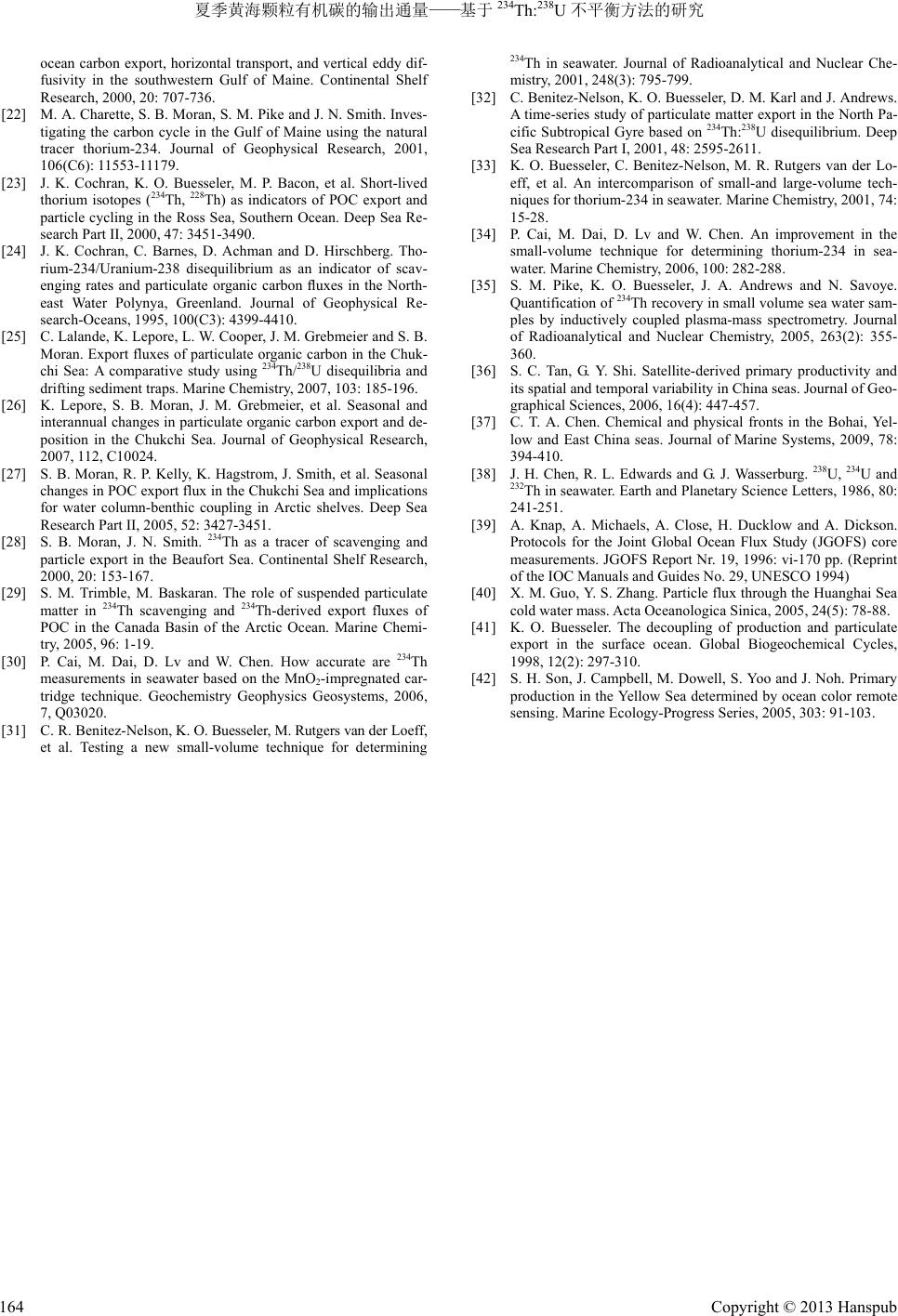 夏季黄海颗粒有机碳的输出通量——基于 234Th:238U不平衡方法的研究 Copyright © 2013 Hanspub 164 3451-3490. urnal of Geophysical Re- 007, 103: 185-196. 5, 52: 3427-3451. of suspended particulate te matter export in the North Pa- d large-volume tech- lume technique for determining thorium-234 in sea- e sea water sam- tial and temporal variability in China seas. Journal of Geo- stems, 2009, 78: awater. Earth and Planetary Science Letters, 1986, 80: for the Joint Global Ocean Flux Study (JGOFS) core 8-88. w Sea determined by ocean color remote ocean carbon export, horizontal transport, and vertical eddy dif- fusivity in the southwestern Gulf of Maine. Continental Shelf Research, 2000, 20: 707-736. [22] M. A. Charette, S. B. Moran, S. M. Pike and J. N. Smith. Inves- tigating the carbon cycle in the Gulf of Maine using the natural tracer thorium-234. Journal of Geophysical Research, 2001, 106(C6): 11553-11179. [23] J. K. Cochran, K. O. Buesseler, M. P. Bacon, et al. Short-lived thorium isotopes (234Th, 228Th) as indicators of POC export and particle cycling in the Ross Sea, Southern Ocean. Deep Sea Re- search Part II, 2000, 47: [24] J. K. Cochran, C. Barnes, D. Achman and D. Hirschberg. Tho- rium-234/Uranium-238 disequilibrium as an indicator of scav- enging rates and particulate organic carbon fluxes in the North- east Water Polynya, Greenland. Jo search-Oceans, 1995, 100(C3): 4399-4410. [25] C. Lalande, K. Lepore, L. W. Cooper, J. M. Grebmeier and S. B. Moran. Export fluxes of particulate organic carbon in the Chuk- chi Sea: A comparative study using 234Th/238U disequilibria and drifting sediment traps. Marine Chemistry, 2 [26] K. Lepore, S. B. Moran, J. M. Grebmeier, et al. Seasonal and interannual changes in particulate organic carbon export and de- position in the Chukchi Sea. Journal of Geophysical Research, 2007, 112, C10024. [27] S. B. Moran, R. P. Kelly, K. Hagstrom, J. Smith, et al. Seasonal changes in POC export flux in the Chukchi Sea and implications for water column-benthic coupling in Arctic shelves. Deep Sea Research Part II, 200 [28] S. B. Moran, J. N. Smith. 234Th as a tracer of scavenging and particle export in the Beaufort Sea. Continental Shelf Research, 2000, 20: 153-167. [29] S. M. Trimble, M. Baskaran. The role matter in 234Th scavenging and 234Th-derived export fluxes of POC in the Canada Basin of the Arctic Ocean. Marine Chemi- try, 2005, 96: 1-19. [30] P. Cai, M. Dai, D. Lv and W. Chen. How accurate are 234Th measurements in seawater based on the MnO2-impregnated car- tridge technique. Geochemistry Geophysics Geosystems, 2006, 7, Q03020. [31] C. R. Benitez-Nelson, K. O. Buesseler, M. Rutgers van der Loeff, et al. Testing a new small-volume technique for determining 234Th in seawater. Journal of Radioanalytical and Nuclear Che- mistry, 2001, 248(3): 795-799. [32] C. Benitez-Nelson, K. O. Buesseler, D. M. Karl and J. Andrews. A time-series study of particula cific Subtropical Gyre based on 234Th:238U disequilibrium. Deep Sea Research Part I, 2001, 48: 2595-2611. [33] K. O. Buesseler, C. Benitez-Nelson, M. R. Rutgers van der Lo- eff, et al. An intercomparison of small-an niques for thorium-234 in seawater. Marine Chemistry, 2001, 74: 15-28. [34] P. Cai, M. Dai, D. Lv and W. Chen. An improvement in the small-vo water. Marine Chemistry, 2006, 100: 282-288. [35] S. M. Pike, K. O. Buesseler, J. A. Andrews and N. Savoye. Quantification of 234Th recovery in small volum ples by inductively coupled plasma-mass spectrometry. Journal of Radioanalytical and Nuclear Chemistry, 2005, 263(2): 355- 360. [36] S. C. Tan, G. Y. Shi. Satellite-derived primary productivity and its spa graphical Sciences, 2006, 16(4): 447-457. [37] C. T. A. Chen. Chemical and physical fronts in the Bohai, Yel- low and East China seas. Journal of Marine Sy 394-410. [38] J. H. Chen, R. L. Edwards and G. J. Wasserburg. 238U, 234U and 232Th in se 241-251. [39] A. Knap, A. Michaels, A. Close, H. Ducklow and A. Dickson. Protocols measurements. JGOFS Report Nr. 19, 1996: vi-170 pp. (Reprint of the IOC Manuals and Guides No. 29, UNESCO 1994) [40] X. M. Guo, Y. S. Zhang. Particle flux through the Huanghai Sea cold water mass. Acta Oceanologica Sinica, 2005, 24(5): 7 [41] K. O. Buesseler. The decoupling of production and particulate export in the surface ocean. Global Biogeochemical Cycles, 1998, 12(2): 297-310. [42] S. H. Son, J. Campbell, M. Dowell, S. Yoo and J. Noh. Primary production in the Yello sensing. Marine Ecology-Progress Series, 2005, 303: 91-103. |